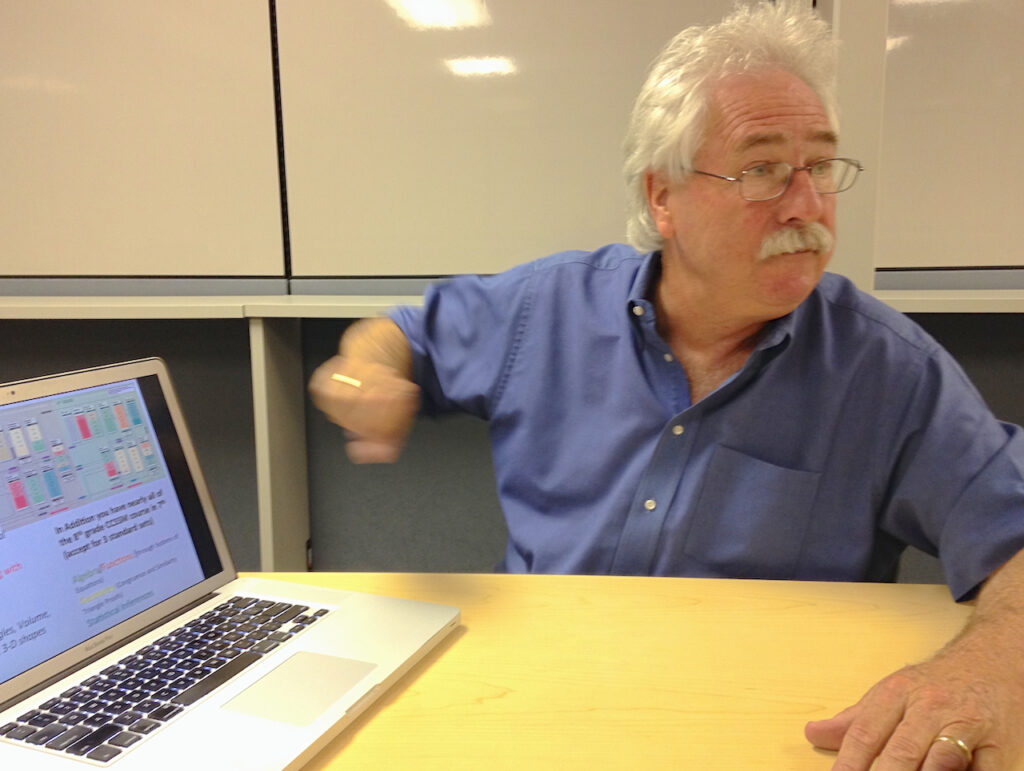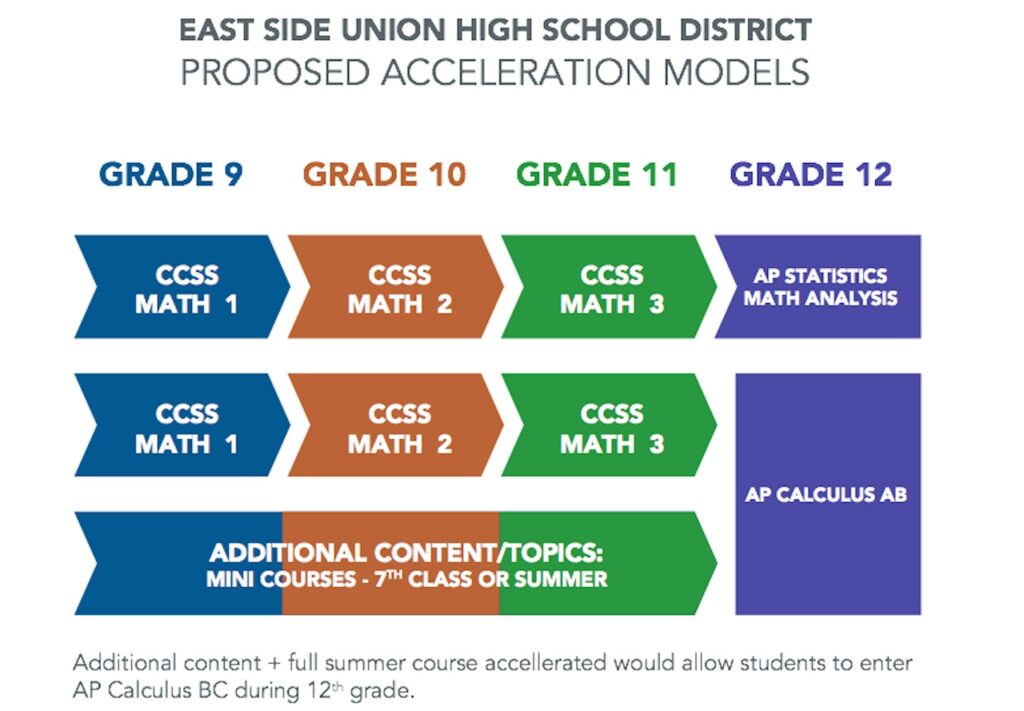Districts split on high school math choicesBy John Fensterwald | EdSource http://bit.ly/1sWNO1C
August 12, 2014 | In moving to the Common Core State Standards this year, California school districts had to choose between serving up high school math as one big stew or as the curricular equivalent of separate courses. That option has created strong, sometimes passionate disagreements among parents and teachers who argue that a blended or “integrated” approach offers a clearer method of instruction and those who prefer sticking with a familiar sequence of courses. The latter group includes high-achieving districts in Silicon Valley. A second look at accelerationThe adoption of Common Core and switch to local control have renewed the debate on when students should accelerate to take Calculus in high school and who should take advanced courses. See accompanying article.In the “traditional” sequence, Algebra I will be taught in 9th grade, followed by Geometry, then Algebra II in the junior year, leading to pre-calculus, Advanced Placement statistics, or, if students are more advanced, Calculus in their senior year. In “integrated” math, as the name implies, the same standards for algebra, geometry, trigonometry and statistics are reassembled and woven together to show their interrelationships in three yearly courses of increasing difficulty. Proponents are also calling this Mathematics I, II, and III or International I, II and III, because, they point out, math is taught this way in most high performing nations. California was one of 46 states, along with Washington, D.C., that adopted the nationwide Common Core standards in math and English language arts four years ago, although three states – Indiana, South Carolina and Oklahoma – have recently rescinded them, and two more states may also do so. The academicians who wrote the Common Core math standards on behalf of the nation’s chief state school officers and a bipartisan group of governors were agnostic about the two pathways for high school math. Either, if taught effectively, they said, would prepare students well for work and college in the 21st century. Some states, including New York, have chosen the traditional sequence, while others, including Utah and West Virginia, have chosen the integrated approach. In adopting the Common Core and subsequently approving a set of frameworks or guidelines for implementing them, the California State Board of Education decided that school districts should decide which pathway works best for them. There is no current count of which approach districts are choosing. A questionnaire by the California County Superintendents Educational Services Association in fall 2013 found slightly more districts choosing integrated (34 percent) than traditional (26 percent) but 40 percent hadn’t yet decided. Among California’s largest districts, Los Angeles Unified, Long Beach Unified and – for at least next year – Fresno Unified are going with the traditional sequence while San Diego Unified, San Francisco Unified, Sacramento City Unified and Santa Ana are going with integrated math.
Among the proponents of integrated math is David Foster, the executive director of the Silicon Valley Math Initiative, which trains teachers and provides testing resources to districts, charter organizations and private schools. Common Core’s K-8 curriculum is already integrated, he said, introducing concepts of algebraic thinking (problems involving division and multiplication), fractions and geometry (areas of rectangles) in early grades, and then gradually adding complexity in middle school. Only in American high schools, he said, are Algebra and Geometry segregated, with a gap of a year separating beginning and advanced algebra and trigonometry. “It makes a lot more sense for students to learn some Algebra this year and some next year, than to say, ‘Stop, do Geometry and then go back to Algebra,’” he said. Less frustration, higher completion?Barbara Schallau, the subject area coordinator for math in East Side Union High School District in San Jose, agreed. The district is transitioning to integrated math starting this fall. “All students would be better off going through an integrated pathway because it allows the development of concepts over time,” she said. “There is continuity and, more importantly, students revisit topics at a higher level, when they are more mathematically mature.” Schallau is confident that the new Common Core 8 th grade math, which will include some of what had been covered before under Algebra I, will give students a solid grounding for high school math. Before, she said, students who initially struggled with Algebra I in 8th grade would become frustrated and hate math after repeating it once, sometimes twice in high school. Because high school students will view three years of integrated math as a package, not discrete courses, more will graduate qualified to attend the University of California or the California State University, she predicts. And more, she hopes, will go on to take pre-calculus or AP statistics.
Although some East Side Union math teachers are as optimistic, some are skeptical. Catherine Duhring, a fifth-year Algebra and Geometry teacher at Mount Pleasant High who is leading the school’s transition to Integrated I, said she is excited about Common Core’s potential to engage students in real-world problems and challenge their passive approach to learning math. “Some kids just want to memorize the tricks to solving problems. I want them to make sense of math, to persevere to find answers on their own so they can say with confidence, ‘I can handle this.’” But her colleague at Mount Pleasant, 20-year veteran Sudhir Karandikar, says it is unrealistic to expect students in a standard class period to learn skills and procedures in multiple math domains and do project-based learning. “There will be far more engagement in theory but there also could be more frustration,” he said. Safer option for a challenging transitionDuhring and Karandikar do agree that implementing Integrated I in the coming year will be difficult. They expect incoming 9th-graders who have not benefited from Common Core math in 8th grade will have big gaps in knowledge. And they will be teaching on the fly, developing lesson plans for an open-source curriculum, the Mathematics Vision Project, developed in Utah. “It’s very overwhelming,” Duhring said. “Every time I think about it my brain shakes.” James Lianides, superintendent of the Sequoia Union High School District, whose students come from high- and low-income communities in San Mateo County, said that, in theory, integrated math “wins on points.” “In an ideal sense, I agree integrated is a stronger approach to math,” Lianides said. But there’s no data to show that integrated will get better results, he said, especially in the transition, when all districts are struggling to train teachers in the new standards and find adequate textbooks and materials. Asked for their views, about 60 percent of teachers responding in Sequoia favored the integrated approach. Lianides recommended traditional and the five-member schools board backed that choice, 3-2. For Lianides and Barry Groves, superintendent of the Mountain View-Los Altos High School District, where 20 percent of students come from low-income families and 70 percent of graduates go on to four-year colleges, the decision to stick with the traditional sequence was pragmatic. “We’ve had a lot of success with the current math program in getting kids ready for college,” Groves said. Making accommodations within an existing curriculum instead of starting from scratch to build a new one removes a layer of complexity and creates one less worry for teachers who already are feeling pressure, he said. But districts that choose traditional could be missing an opportunity,said Gina Dalma, senior education program officer for the Silicon Valley Community Foundation. The foundation has underwritten discussions between K-8 feeder districts and high school districts throughout Silicon Valley about Common Core math options. Dalma worries “there will be no impetus to change instruction,” which is necessary to effectively implement Common Core, with its dramatically different mix of content and skills. “Integrated math is more of a refresh – an opportunity to rethink how kids are placed and start with a clean slate,” she said. She is concerned that without that clean break, the traditional sequence will perpetuate the status quo, including the tracking of students, a practice based on the assumption, starting in early grades, that minority kids and English learners can’t handle advanced math courses. East Palo Alto Academy, a charter high affiliated with the Stanford School of Education, will be the one school within Sequoia Union High School District that will teach integrated math this fall. With 40 percent English learners and nearly all low-income students, East Palo Alto Academy already has begun introducing Common Core math, says Morgan Marchbanks, a former assistant Sequoia superintendent who is now principal of East Palo Alto Academy and chief academic officer of Stanford New Schools. Like Schallau, a firm believer in the value of integrated math, Marchbanks predicts that districts will consider switching to the integrated pathway “once we demonstrate that kids will do well and college acceptances won’t be hurt.” UC, CSU are agnostic on pathwaysWhen it comes to the math debate, there is common ground. Supporters of both pathways say that each approach, by stressing problem solving over memorization and mastery of procedures – a common criticism of California’s math standards – will be very demanding. In a presentation before the State Board of Education, Chris Dell, director of K-12 Mathematics and Technology for the Shasta County Office of Education, characterized Common Core’s focus on a deeper understanding as a shift from “how to why.” There’s also agreement that Common Core will be a heavy lift for teachers, who will be asked to do more coaching and less lecturing from the front of the class.
Compared with the old Algebra I, both Integrated I and Common Core Algebra I will assume that students know more at the start of the year and will take students further by the end of year. That’s because Common Core’s 8th-grade math will cover topics previously offered in California’s version of Algebra I. Going Deeper
Both pathways are acceptable for admission to the University of California. Twice over the past year, the UC faculty board that oversees high math school courses has said it doesn’t prefer one option over the other. But that didn’t mollify many parents in the wealthier districts of Silicon Valley, where students compete to get into the top University of California campuses and private colleges. For those parents, the traditional path was the safer option. “I had not one request from a parent to go integrated,” said Groves. “I got many questions from parents worried we might go integrated.” None of the private schools in the region are choosing integrated, Groves said, another factor behind their decision. Foster characterized the parents’ perceptions as, “We are winning, so don’t change the rules. We already can get kids to go to Stanford and MIT.” Parents who know how to help their students with Geometry didn’t understand the rationale behind Integrated II and why it might be better for their kids, he said. But Foster also acknowledged that in the end, what will matter most will be implementation in the classroom, not the choice of pathway. “Nobody has ever said standards change education or teaching,” he said. “Class size does not matter, what curriculum you use does not matter. All that ever matters is teaching. And so will this help teachers be better at teaching? I hope so.” | New twist to old debate on accelerated mathBy John Fensterwald | EdSource http://bit.ly/1kCsjlD
August 12, 2014 |For the decade before the adoption of Common Core State Standards in 2010, the policy of the State Board of Education was to make Algebra I the standard course for 8th-graders so they could progress to Calculus in high school. California was distinct among states to do so, and results were decidedly mixed. The number of students taking Algebra I soared over that period, mostly among Hispanic and African-American students, with nearly two-thirds of students taking Algebra I or Geometry (about 8 percent of students) by 8th grade. Distinct options for high schoolDistricts can offer high school math the traditional American way or blend Algebra and Geometry together, the way other nations do. The choice has set off heated discussions.<<See accompanying article<< The proficiency rate on the state standardized test for Algebra increased to 46 percent in 2012. But that also meant that over half didn’t pass the test and 29 percent of students scored far below basic – evidence that they were assigned Algebra I before they were ready. Reassigning them the same course in 9th grade didn’t work: only about one in five tested proficient the second time around. They’re among the students whom Barabara Schallau, the math coordinator for East Side Union High School District in San Jose, predicts will do better in high school math under a new sequence of Common Core courses. After getting a grounding with elements of Algebra in Common Core 8th grade, they will take the first of three integrated math courses in 9th grade that combine Algebra I, Geometry, Algebra II, statistics and functions (the study of operations using variables to produce a single result). With the switch to Common Core, the State Board of Education eliminated the policy – what state board President Michael Kirst characterized as a “minor branch of theology”– that it was critical in 8th grade to propel the majority of students toward advanced math. The state board’s neutrality, however, didn’t end the debate over acceleration – it just shifted it from Sacramento to local districts, where some districts are continuing what they’ve been doing, and others are experimenting with options in different grades, with more reliable criteria to determine who’s ready to accelerate. The committee of California educators writing the math frameworks for Common Core, which the state board adopted last year, has strongly cautioned districts not to push students into accelerated courses in middle school too soon. Common Core 8th grade math is more rigorous than the pre-Algebra 8th grade math under the California standards, it noted.
“Decisions to accelerate students into the Common Core State Standards for higher mathematics before 9th grade should not be rushed. Placing students into an accelerated pathway too early should be avoided at all costs,”the appendix on course options reads. Parents not familiar with Common Core may not understand the rationale for a more measured course progression in middle school and the differences in rigor between 8th grade Common Core and the old 8th grade math. “There needs to be more communicating with parents,” acknowledges Pamela Seki, assistant superintendent of curriculum, instruction, and professional development at Long Beach Unified, which is among the California districts furthest along in implementing the Common Core. Last spring, 900 parents in the Los Gatos Union School District signed an online petition and jammed a series of board meetings when they heard the district was considering eliminating the option of taking Geometry in 8th grade. “If current and future students do not have it available, the lack of this program could affect the reputation that Los Gatos has for its commitment to top-quality education,” read the petition, pushed partly by realtors, according to the San Jose Mercury News. The superintendent and trustees said that parents misunderstood their intent. The district eventually adopted a three-track plan that included offering Common Core Algebra I and Geometry, along with 8th Grade Common Core, in 8th grade. Some sort of acceleration is the only way for students to take at least one year of Calculus by the time they are seniors. Double acceleration would be needed to enroll in the follow-up course, Calculus BC, the goal of students aiming to major in science and engineering at top-flight colleges. High school districts are considering a range of acceleration options for students to take calculus by their senior year or sooner: compacting three years of integrated math into two or offering double periods of math, such as Geometry and Algebra II for those districts offering the traditional sequence.
East Side Union will take another tack. Integrated math courses include optional “plus standards,” designed for science and engineering majors. By adding an extra daily mini-course to teach those standards, students will bypass pre-Calculus after taking Integrated Math III as juniors and take Calculus as seniors, Schallau said. Unified and K-8 districts are exploring honors courses, which would compact three years into two years in sixth and seventh grades. Depending on whether a district offers an integrated or traditional sequence of courses, this would lead either to Integrated I or Common Core Algebra I in 8th grade. Long Beach also plans to give 7th graders who didn’t start acceleration in sixth grade a second chance with a summer bridge program leading to Algebra I in 8 th grade, Seki said. Under the new standards, it’s likely fewer students than before will end up taking an accelerated course in middle school, and that’s appropriate, say Kirst and other Common Core advocates. East Side Union’s seven feeder districts have agreed to offer the same Integrated I curriculum for accelerated students in 8th grade that high schools will offer in 9th grade. They will also use the same assessment, the Math Diagnostic Testing Project, developed by the University of California, to determine which students are ready for Integrated I in 8th grade. In Silicon Valley, the Santa Clara-based nonprofit ALearn and the Silicon Valley Education Foundation are offering free summer acceleration and remediation courses to more than 2,000 minority and low-income students entering 8th and 9th grades. “It’s an equity issue,” said Manny Barbara, a retired superintendent who is vice president of the Silicon Valley Education Foundation. “Will students, no matter where they go to school, have the same opportunity as those attending the more affluent districts?” Under the California state standards, textbook publishers dictated what would be taught in accelerated courses, Seki said. Now, she added, there’s innovation, with different courses in different grades covering a range of standards, eventually offering lessons on what works best. But the proliferation of options is also perplexing the state board as it considers whether and how to create standardized tests for high school. “We are grasping to think through all this,” Kirst said at the state board meeting last month
|
This page is a compendium of items of interest - news stories, scurrilous rumors, links, academic papers, damnable prevarications, rants and amusing anecdotes - about LAUSD and/or public education that didn't - or haven't yet - made it into the "real" 4LAKids blog and weekly e-newsletter at http://www.4LAKids.blogspot.com . 4LAKidsNews will be updated at arbitrary random intervals.





No comments:
Post a Comment